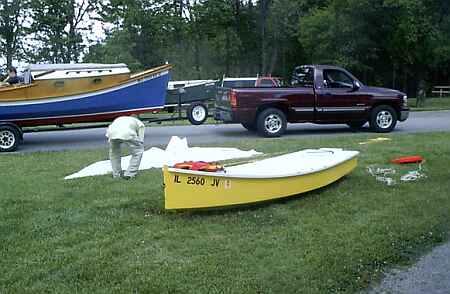
Getting ready at Rend Lake.
Contents:
Contact info:
Jim Michalak
118 E Randall,
Lebanon, IL 62254Send $1 for info on 20 boats.
Jim Michalak's Boat Designs
118 E Randall, Lebanon, IL 62254
A page of boat designs and essays.
(15jun08)This issue present the 2008 Rend Lake Messabout. The 1 July issue will rerun the rowboat setup essay.
WELCOME TO ...
If you got this far I hope you will bookmark it and hopefully it will be permanent. There is lots of room to grow here. It may take a while for me to upload the old issues but you should be able to dig them out of the old earthlinks sight and maybe the even older apci sight and finally there are the old reliable archives at duckworksmagazine.com. I will keep my email at jimmichalak@earthlink.net for now.
THE BOOK IS OUT!
BOATBUILDING FOR BEGINNERS (AND BEYOND)
is out now, written by me and edited by Garth Battista of Breakaway Books. You might find it at your bookstore. If not check it out at the....ON LINE CATALOG OF MY PLANS...
...which can now be found at Duckworks Magazine. You order with a shopping cart set up and pay with credit cards or by Paypal. Then Duckworks sends me an email about the order and then I send the plans right from me to you.

|
Left:
Getting ready at Rend Lake.
|
|
|
Rend Lake 2008
IN SPITE OF RECORD GAS PRICES, EXTREME HEAT AND WINDS, AND TORNADO WARNINGS....
...we actually had a record turnout at the 2008 Rend Lake Messabout. 36 boats we think. I was stunned! The winds blew at 30 mph Friday through Sunday, that is the entire weekend. The lake was a mass of whitecaps except at sunrise and sunset. As you will see almost all the photos I took were of land bound boats and those that parked in quiet coves. I didn't go out to photograph the brave on the open water. I didn't get to photograph all the boats and there is a possibility that other photographers may contribute more photos in time.
I arrived about 11 on Friday to find a number of folks had set up on Thusday. Tom Hamernik from Chicagoland also had just arrived with his CLC kayak on the roof and his Mixer on a trailer. Said he nearly got blowed away on the highway up north where the winds were even stronger. Here is the lead photo again showing Tom rigging his Mixer. A Skiffamerica20 is in the background, probably Bill Dulin's, and my AF4 is behind that.

Here is a better photo of Bill Dulin's boat, one of four Skiffamericas to make the meet.

There was another, a non regulation green hull, from Colorado that I didn't get to photograph. But here is the original Skiffamerica, with designer Kilburn Adams in front:

And here is the fourth by Robert Cope in the water with Bill Dulin's and Kilburn Adams' boats behind:

Near my camp pad was Chris Feller with his Philsboat. He said he added 100 pounds of ballast (lead shot) as insurance although he had never capsized it. At least not until Saturday. He went out with Tom Hamernik under full sail and eventually got blasted over. He said he saw the water brush up against the side window, lost rudder control as the rudder was now out of the water, it rounded up nicely and then righted nicely. Well, that is how it is supposed to work. I think they brought it back in after that. Here it is parked between two PD racers...

We had four PD racers that I saw. The white one above is that of old friend Dave Gray who is the white polytarp sail man. The yellow boat behind belonged to John Nystrom. These two guys were sane and cautious. But the other two PD's by brothers Ken Giles and Bill Giles went out into the thick of it for a few hours and returned to tell about it. "Radical!" he says. Alas, didn't get their photos.
I should mention that Tom Hamernik went out in his Mixer with Chris Feller for hours, one man sailing and the other man bailing. Said he took solid green (actually around here it is brown) water completely over the hull at times. Nothing broke but they returned totally soaked. He went out again on Saturday with John Nystrom but this time even Tom chickened out. Big waves and big wind rolled him deep enough for solid water over the side and they limped back with the cockpit a third full of water. But before that we watched them blasting across the lake out of sight at times.
And I should mention that I did indeed launch my AF4 with new bottom, forgetting to get a photo of my own boat. No leaks. Engines had not been run for two years. The Sea King 15 popped to life after maybe 100 pulls and continued to run filling the inlet with its smoke. Then it was fine. The Sears5 backup wouldn't wake up. I ventured out enough to experience the pounding and decided to turn tail considering the conditions and my shaky motors. Returning I was accompanied by the Colorado Skiffamerica who was also quite ready to get back on solid ground.
But let's contiunue our walk around the campground on Friday. Next on my path was Phil Reed. Last year he brought a new Toto but this year he had his older aluminum canoe with its many attachments. Here it is with most of its sailing rig, plus an add on sliding seat rig in the the background that Phil made himself.

Next in line was a restored 1959 Crestliner with a restored 1973 Evenrude by Tom Wawrzyniak, brother of motor guru Max.

Speaking of Max Wawrzyniak, he brought two boats. The solo kayak was at Rend last year and the two holer is new this year. Max does an awful lot to organize this meet and I thank him.

Down at the shore of the loop were several smaller boats that were hand launched on the spot. I didn't get photos of them all but I got this one of Grant Maclaren with his electric Uncle Jons pirogue.

Also in that group was Rovie Alford with a Piragua18 (and rowing bits that he used to use on his factory canoe).
There did seem to be a move to smaller boats this year. Several kayaks, factory, plywood and strippers, that I didn't get to photograph. The group was pretty active in the rough water. If I didn't get photos, we did get some names on the sign up sheet. They include Mark Escher, Joe Feager, Tracey Grezegorczyk, all from the St Louis area.
Here is one that I got a photo of but never met the builder. I think it is a sailing stripper by John Monroe:

Next on the loop was Rob Rhode-Szudy with his AF4b. He has modified the boat somewhat, mostly lowering the sheer aft so his kids can wave their hands in the water. He also changed the front of his cabin similarly to what I did with my AF4, but I think this was before he saw my article. I got to ride with him and Max on Saturday, nice boat. Rob has his steering rigged with an old fashioned control stick on the cockpit side and it worked great.

Next up was something of a mystery. I thought it was a Bolger dory. I built one of those once and this boat seems an exact double of that. But no such boat appeared on the signup sheet. What this probably is is a "South Haven Dory" by Ron Vansaghi:
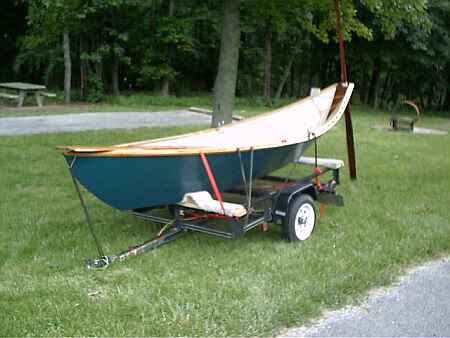
Returning to my camp pad I saw Paul Ellifrit, a regular at the messabouts, had arrived but this year no slide in camper in a big pickup, instead a new little lapstreak canoe on a compact Honda. He said the wind nearly blew the canoe off the roof on the drive from Columbia, Mo. The canoe, perfectly done as Paul does them, is a Sassafras 14 with decks added:

Also moving in were Terry and Devin Gardener, all the way from Moulton, Alabama. They had a plastic canoe this year but are abuilding something for next;
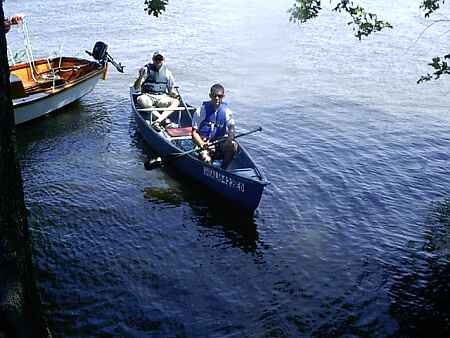
Also back at the loop I could see that Doug Cameron was getting ready to launch the Core Sound 20 he had built. This photo is taken as he rigged it near the launch ramp in a rare shady spot:
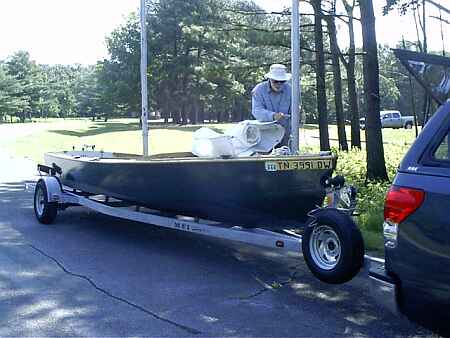
This is a big powerful racing/cruising boat. Its close cousin won the Everglades Challenge last year. In the water, with double reefed main and a single reefed mizzen she looked like this:

I poked around the Watertribe.com (Everglades Challenge) site a bit and decided Doug is aka Ridgerunner. He finished 5th this year, 3rd in 2006, 12th in 2005, 1st in 2004 (WOW), and 12th in 2003. So he has the miles under his keel. I kept bugging him about race details.
Down in the cove I saw Larry Applebaum's Nancy' China. Larry slept on board through all the nights tied up in the launch cove and also in the camping cove. Larry has been coming to our meets for a long time..

Setting up camp were JIm Michels & son who brought this nice skin/frame kayak. The "skin" is actually just cotton duck cloth painted with oil based Rustoleum, I think. Made it themselves...
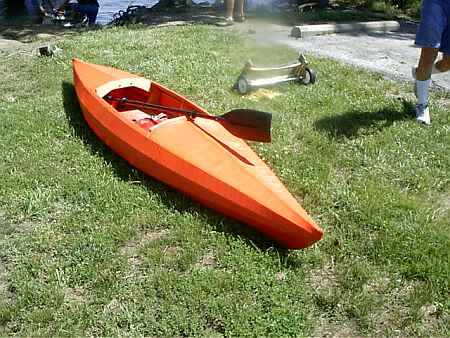
Nearby were Rich Scobbie and familty with this beautiful restored 1960 Sportcraft. A beautiful job!

There were two other classic outboards that I missed photographing. Fred Droney brought a home made William Jackson "Ace" with a 1957 Johnson 35. And Jeff Hoessel had a restored Barbour lapstrake runabout with a "direct reversing" Merc outboard (doesn't shift to reverse, the engine rotation reverses!). Jeff spent a few hours tubing his family.
Actually there were some calm periods, a few minutes around sunrise and sunset. Here Steve Lewis goes for a quiet cruise on his Scout Canoe set up to sail. Along side him looks like Doug Gray again in his PD.

And finally Currie Bishop of "ain't got no rudder sailing canoe" fame has apparently decided that the rudder is a great invention after all. This year he brought a Summer Breeze with rudder. The sail is from the old canoe rig thought. Sweet sailing boat.

Did I miss anyone??
On Saturday evening we have something of a pot luck dinner. Max did the cooking again and it was GREAT!!! Both apple and peach cobbler cooked in Dutch ovens with ice cream!

Vector

VECTOR, SAILBOAT, 15' X 5.5', 350 POUNDS EMPTY
Every now and then I draw up a sailboat with a centerboard. A boat with a centerboard can have a prettier rig sometimes because the rig does not have to be centered over the hull's widest beam, as it does with a leeboard boat. But the sail area still has to be right above the centerboard for the boat to balance well. In Vector's case, the widest hull beam is 10' aft and the centerboard is between 4' and 8' aft. And that is the downside of the centerboard - it takes up some the prime space inside the hull.
Some designs will skimp on the centerboard size in order to take up less prime space but the result of that will always be more leeway when sailing to windward. In round numbers the area of the board that moves through the water needs to be about 4% of the sail area to efficiently counteract the full side force of the sail. Essentially the centerboard "flies" through the water in the same way that an airplane's wing flies through the air. True, water is about 900 as dense as air but things conspire to keep the centerboard from getting 900 times as much force from a given area. First the centerboard cannot develop a really high lift coefficient since it must be symmetric in cross section in order to operate on both tacks, unlike a soft sail which can be shaped with camber to reach a Cl of 1.5 in a good sail and maybe 2.0 in a great sail. Worse yet is the fact that the centerboard will flow through water at a fraction of the wind speed, and if your boat is beating to windward at 3 knots in a 15 knot wind, the 4% rule works out almost exactly. That is the worst case - beating to windward especially in rough water. If your boat were to hit a big wave and slow down below 3 knots, or if the centerboard were undersized to start with, the board will "stall" and develop no more lift no matter how much angle of attack (leeway to a sailor) you demand of it. The only solution would be to "fall off" the wind, pick up more speed, and try again just as an airplane pilot needs to recover airspeed after a stall.
Vector was inspired by the 12' Skat. It will be a much better family boat than Skat because of its greater capacity. Two adults and two kids would do it. There is a huge water tight storage volume behind the cockpit. The transom is quite wide and will take a small motor on a bracket mount, or you might try building in a motor notch to one side.

She's V bottomed as you see. Should be fast and handy, better than a flat bottomed boat although she will be a bit tippier and draw a bit more water than the flat bottomed boat.
There are two prototype Vectors that I know of. The first was by Peter Mohylsky down on the Gulf Coast (hope it is still there).

I never heard much of that boat but the second by Mike Sandell showed up at the 2006 Rend Lake Messabout much to my surprise (I had to ask what it was) and I got to talk to Mike and see it sailing for two days. Mike has a website at http://www.geocities.com/michsand@sbcglobal.net/ (archived copy) where the building is well covered. He was still quite new to the boat but especially on the second day, after he had tweaked the lines on his polytarp sail, he had no trouble sailing and sometimes leading the fleet.

I asked Mike to write a bit about the experience and he responded:
"My Vector was built over a period of five months in 2005, beginning in March of that year. The wood used was AC grade plywood purchased from the Menards home improvement store, with framing purchased both at Menards and Home Depot. The large pieces were cut to shape using a table saw with the blade set to a shallow cut. Small pieces were cut with a sabre saw.
"The glue used in the project was Titebond III, produced by Franklin International. which is an ANSI/HPVA Type I waterproof glue. Clamping of parts on the project was accomplished using a combination of deck screws and PVC clamps.
"Parts were cut in my basement workshop, and assembly was done in the garage. Taping of the seams was accomplished using marine epoxy and fiberglass tape purchased from Chuck Lienweber at Duckworks Boatbuilders. Two layers of tape were applied to both the inside and outside of all seams. Filling was done using both epoxy filled with wood flour, and also polyester auto body filler, depending upon the application.
"The boat was finished using an oil-based alkyd primer and oil-based industrial enamel, also purchased at Menards. Brightwork was various types of moulding pieces, held in place with stainless steel wood screws and stained with a Minwax water-based light oak stain. Final finishing of the brightwork was done using Johnson's Paste Wax.
"Fittings were all purchased from Duckworks. Running rigging is all braided nylon line from the home improvement stores, except for the mainsheet, which is twisted polypropylene, which is easier on the hands than nylon cord. The sail was made using a kit from Polysail International, and was completed in a single day, as advertised. The working lines for the sail are both led to cam cleats on the rear top end of the centerboard box. The mainsheet goes through a traveller mounted on the rear deck, and from there through turning blocks on the underside of the boom and finally to a block on the back of the centerboard box. The rig includes a boom vang, and the boom sets on the mast about fifteen inches above the deck when the sail is properly set.

"My boat includes four minor departures from the plans. The first is centerboard box. The plans call for cutting the bottom of the box to fit the curve of the hull bottom, setting the box on top of the hull, and then glassing it in place. I didn't see any way that I would successfully cut the box to precisely match that curve, so instead I cut the bottom slot wide enough to fit the centerboard box through it. I then glassed it in place from the inside, carved and sanded the protruding end of the centerboard box to match the outside curve of the hull, and then glassed the outside edges to finish the installation.
"The second change was in the seats. I'm a fairly big guy, and found that changing sides during a tack or jibe was difficult due in part to the limited foot space between the seats. The original seats were fourteen inches wide, and I replaced these with twelve-inch wide seats. The extra four inches made a huge difference for me.
"The third change was in the jaws for the boom. On a windy day last summer (before I had installed the boom vang) I broke the jaws while running downwind. Rather than build a new, long set of jaws, I cut off the broken set short, and then just used a longer cord to wrap around the boom. The cord is waxed to help ease movement, and does not carry any parrell beads. This has worked fine for me since then.
"Lastly, I did not construct my gaff and boom from laminated lumber as specified in the plans. Both are banister rail pieces purchased at Home Depot. The piece used for the gaff felt stiff and heavy, and was used as-is. The piece for the boom felt less robust to me, and got another piece of wood laminated to the flat surface on the bottom. I think I cut that one a bit too low, however, and it still worried me a bit. I plan on making a new boom this winter, which will have a deeper piece glued to the bottom of the railing to produce a "keyhole" shaped boom, similar to the T-booms seen on other small wooden boats.

"My Vector was named "Valkyrie", in homage to my Swedish ancestry on my father's side. Because of the gaff rig, it takes a bit more tweaking of the sail to get things just right than on simpler rigs. But once set, she really screams. "Valkyrie" accelerates very quickly on reach, and will point nearly as high as a sloop rig. But if the sail is not set properly, she'll flutter and stall in a heartbeat. Really keeps me on my toes! The only additional change I feel the boat needs is a longer tiller for single-handed sailing. Other than that, she is a joy to sail, and was worth every last minute put into her creation.
Taped seam construction. She needs four sheets of 1/2" plywood and six sheets of 1/4" plywood.
Plans for Vector are $40.
Prototype News
Some of you may know that in addition to the one buck catalog which now contains 20 "done" boats, I offer another catalog of 20 unbuilt prototypes. The buck catalog has on its last page a list and brief description of the boats currently in the Catalog of Prototypes. That catalog also contains some articles that I wrote for Messing About In Boats and Boatbuilder magazines. The Catalog of Prototypes costs $3. The both together amount to 50 pages for $4, an offer you may have seen in Woodenboat ads. Payment must be in US funds. The banks here won't accept anything else. (I've got a little stash of foreign currency that I can admire but not spend.) I'm way too small for credit cards.
I think David Hahn's Out West Picara is the winner of the Picara race. Shown here on its first sail except there was no wind. Hopefully more later. (Not sure if a polytarp sail is suitable for a boat this heavy.
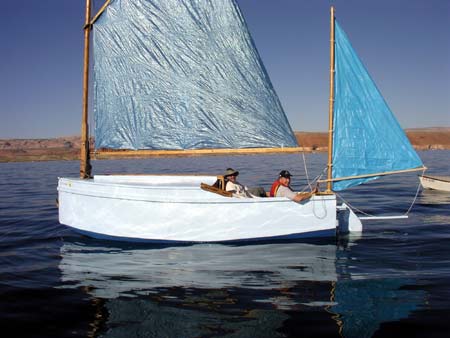
Here is a Musicbox2 I heard about through the grapevine.

This is Ted Arkey's Jukebox2 down in Sydney. Shown with the "ketchooner" rig, featuring his own polytarp sails, that is shown on the plans. Should have a sailing report soon.

And the Vole in New York is Garth Batista's of www.breakawaybooks.com, printer of my book and Max's book and many other fine sports books. Boat is done, shown here off Cape Cod with mothership Cormorant in background, Garth's girls are one year older. Beautiful job! I think Garth is using a small lug rig for sail, not the sharpie sprit sail shown on the plans, so I will continue to carry the design as a prototype boat.
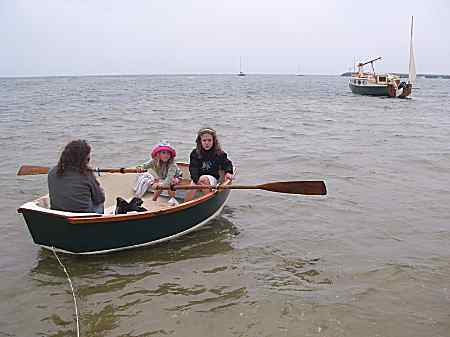
And the Leinweber's make another prototype! This one by Sandra, an Imresboat shown here on its first outing. They are taking it on a "cruise" so more about it later.

Bill Moffit's Mikesboat project is done and finished the Texas 200! I just got this photo of Mikesboat at the start, Chuck Leinweber's Caprice mothership in the background. Haven't heard from Bill yet. (Photo by Stan Roberts who sailed the first 115 miles of the cruise in his Piccup pram, but dropped out facing five foot waves after getting lost a bit.)

And a new Down Under Blobster, now upside down....

AN INDEX OF PAST ISSUES
Hullforms Download (archived copy)
Plyboats Demo Download (archived copy)
Brokeboats (archived copy)
Brian builds Roar2 (archived copy)
Herb builds AF3 (archived copy)
Herb builds RB42 (archived copy)